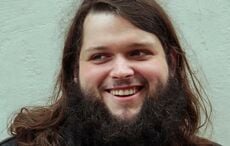For IrishCentral's full coverage of this year's North American Irish Dance Champs, CLICK HERE
Sunday was gentlemen’s day at the North American Irish Dance Championships. Men and boys of all ages are milling about, some as young as 9, others in their 20s.
So what keeps a guy dancing, when other sports, school and girls could distract him?
Sean Kennedy was among the first to dance in the under 20 competition, and IrishCentral spoke to him after he exited the stage. Beads of sweat were still gathered on his forehead, and it was clear enormous exertion had gone into the dance.
“Boys have to be more powerful,” says Kennedy, who is in the Butler-Fearon-O’Connor school in Los Angeles (which his mother part-runs), and has been dancing for 12 years.
In Sunday's dance, he did well because he moved as fast as he could, hitting the corners of the stage. “You have to jump higher than the girls – you have to dance like a man.”
Kennedy loves the atmosphere of the Irish dancing community, and he says many of the other male dancers are his buddies.
He was going to go to Denver this weekend with other friends, but changed his mind at the last minute and came to compete in Nashville because he didn’t want to miss out.
Christopher Johnson, from Virginia, was also clear about his love of dancing. “It’s my passion,” he explains.
Johnson’s roots are German, Native American and African American. He fell in love with dancing when he saw "Riverdance" at the age of 12. “As soon as I saw it, I knew that was exactly what I wanted to do.”
For Johnson, Irish dance offers a style of movement that other forms of dance don't.
"I always liked tap-dancing,” Johnson says, “but it was a little too flamboyant for me – you gotta wave your hands and smile.”
In Irish dancing, you don’t have to move your arms, and the intricate footwork is “like drumming with your feet," he says.
Johnson, now in his mid-20s, began Irish dancing later than some, but he recently got his first number one placement in a preliminary championship at the Four Provinces Feis. He tries to practice five or six times a week, and when not dancing, he works in Deloitte in Virginia.
A much younger man, Braeden Mahoney, also cited the footwork, the shoes and the friends as the draws of Irish dancing.
From Walpole U.S.A., Braeden is 9, and has been dancing for three years. “I like the music and I like wearing the shoes,” he says, with a serious face. “You’re hitting clicks.”
Braeden lists seven or eight friends he has made through dance, all boys at his school.
Men’s Irish dancing is masculine, exhilarating, and it keeps you fit. It has many of the same benefits for boys as it has for girls – friendship, athletic training, culture and camaraderie.
For those who stick at it, this seems to create a kind of addiction.
When he stops dancing at feiseanna, Sean Kennedy says, he wants to take the teaching exam, and will then teach. He laughs. “I just don’t think I’m capable of staying away.”




Comments